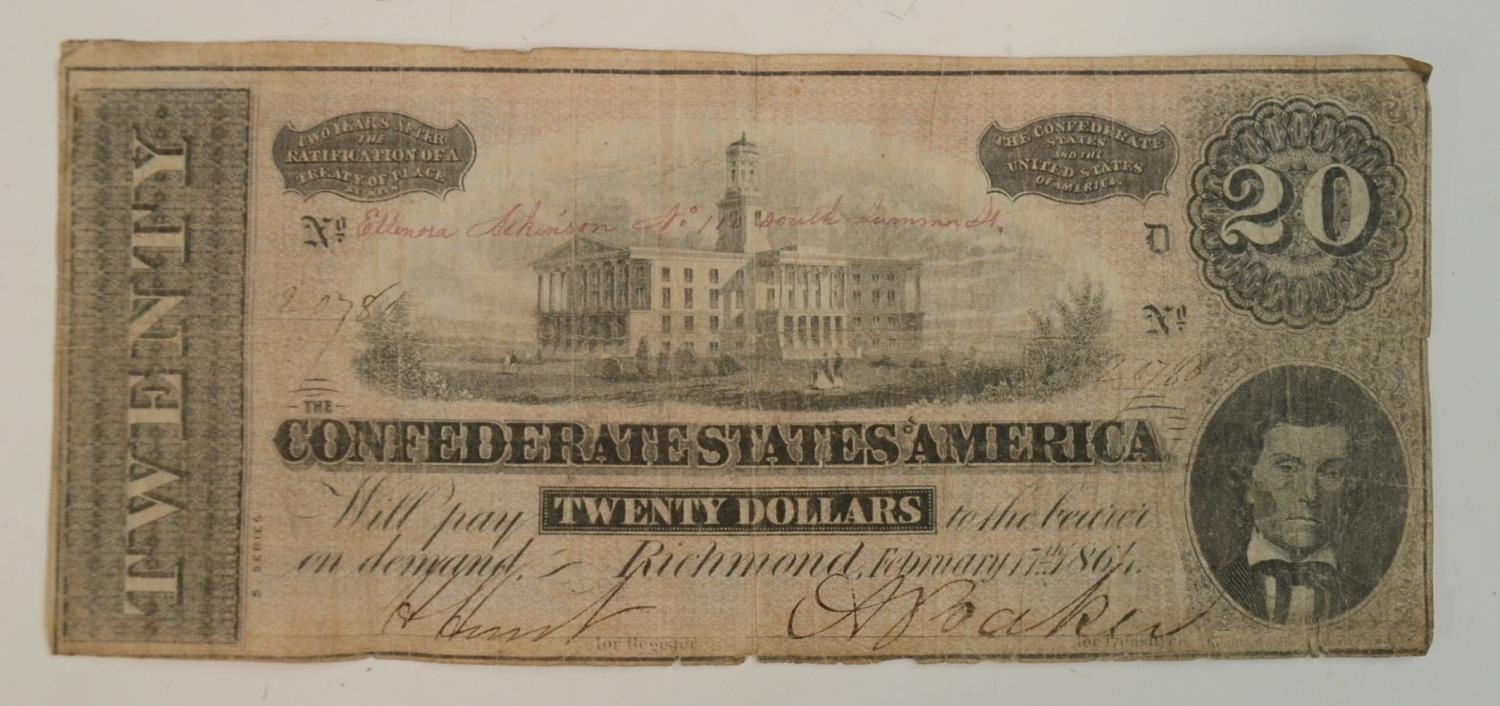CIVIL WAR]. CONFEDERATE STATES OF AMERICA. Constitution of the Confederate States of America . [Montgomery, Alabama: Shorter & Reid? for the Provisional Congress, 9 or 10 February 1861]. Folio, 29 broadsheets printed on rectos only (14 x 8 in.). Printed on fine-quality laid paper, in Roman and italic types, each line of text numbered (within sections), wide space (leading) between lines of text to facilitate annotation and revision. Printed heading: "In Congress-March 9, 1861--Amended Constitution--100 copies ordered to be printed." Beneath, in large type: "Constitution of the Confederate States of America." Neatly sewn together at top margin with string, small marginal tear to first leaf, scattered foxing to a few leaves at beginning and end. WITH 11 CONTEMPORARY MANUSCRIPT CORRECTIONS AND REVISIONS by Alabama delegate Thomas Fearn (1789-1863), M.D., of Huntsville, Ala., the original owner. "WE THE PEOPLE OF THE CONFEDERATE STATES": THE BIRTH OF THE CONFEDERATE STATES OF AMERICA. THE FINAL DRAFT PRINTING OF THE CONFEDERATE CONSTITUTION, ONE OF ONLY TWO SURVIVING COPIES Delegates from the states of South Carolina, Mississippi, Florida, Alabama, Georgia, Louisiana and Texas--all of which had voted articles of secession in the wake of the 1860 election--convened at Montgomery, Alabama, on February 4, 1861, a month before the scheduled inauguration of Abraham Lincoln. Faced with the dire necessity of devising a plan to unite and federate the newly seceded states, to provide for their common fiscal, political and judicial stability, as well as their probable defense, the Provisional Congress drafted a provisional Constitution. Several drafts produced at various stages of the process were sent to a local printer, who hurriedly ran off working copies for the use of the delegates in debate. When the process of revision was complete, the Constitution was unanimously adopted by the Convention in a historic vote on March 11. (See Parrish 5 and 6 for two earlier draft printings and Parrish 8 for the final version.) By the end of 1861, a total of thirteen states had ratified the Constitution. From the preamble, the close resemblance to the United States Constitution is evident: WE, the People of the Confederate States, each State acting in its sovereign and independent character, in order to form a permanent Federal government, establish Justice, insure domestic Tranquillity, and secure the Blessings of Liberty to ourselves and our Posterity--invoking the favor and guidance of Almighty God--do ordain and establish this Constitution for the Confederate States of America . As a result of its superficial resemblance to the Federal constitution, the Confederate Constitution has been generally dismissed as a poor imitation of a shining original, while in fact, it actually embodies very distinctive Constitutional principles of republican government for which the southern states felt compelled to fight. Only recently have constitutional scholars begun to accord it the objective consideration it merits as an ambitious and carefully crafted experiment in American constitutional theory. The Confederacy itself, one such scholar argues, "was the consequence of a constitutional crisis the origins of which could be traced back to the U.S. Constitution of 1787," and, rather than abandoning constitutional principles or the objectives of a federal system, the southern states actually "reaffirmed their commitment to constitutional government" under a revised constitution embodying principles similar in many aspects to those argued by the anti-federalist delegates at the 1787 convention. In addition "the period in which the Confederate Constitution was drafted," De Rosa points out, "marks an important crossroad in American political and constitutional development, the consequences of which are to this day topics of intense debate--topics such as the nature of American federalism, civil rights and liberties, laissez-faire economics and the scope of g
CIVIL WAR]. CONFEDERATE STATES OF AMERICA. Constitution of the Confederate States of America . [Montgomery, Alabama: Shorter & Reid? for the Provisional Congress, 9 or 10 February 1861]. Folio, 29 broadsheets printed on rectos only (14 x 8 in.). Printed on fine-quality laid paper, in Roman and italic types, each line of text numbered (within sections), wide space (leading) between lines of text to facilitate annotation and revision. Printed heading: "In Congress-March 9, 1861--Amended Constitution--100 copies ordered to be printed." Beneath, in large type: "Constitution of the Confederate States of America." Neatly sewn together at top margin with string, small marginal tear to first leaf, scattered foxing to a few leaves at beginning and end. WITH 11 CONTEMPORARY MANUSCRIPT CORRECTIONS AND REVISIONS by Alabama delegate Thomas Fearn (1789-1863), M.D., of Huntsville, Ala., the original owner. "WE THE PEOPLE OF THE CONFEDERATE STATES": THE BIRTH OF THE CONFEDERATE STATES OF AMERICA. THE FINAL DRAFT PRINTING OF THE CONFEDERATE CONSTITUTION, ONE OF ONLY TWO SURVIVING COPIES Delegates from the states of South Carolina, Mississippi, Florida, Alabama, Georgia, Louisiana and Texas--all of which had voted articles of secession in the wake of the 1860 election--convened at Montgomery, Alabama, on February 4, 1861, a month before the scheduled inauguration of Abraham Lincoln. Faced with the dire necessity of devising a plan to unite and federate the newly seceded states, to provide for their common fiscal, political and judicial stability, as well as their probable defense, the Provisional Congress drafted a provisional Constitution. Several drafts produced at various stages of the process were sent to a local printer, who hurriedly ran off working copies for the use of the delegates in debate. When the process of revision was complete, the Constitution was unanimously adopted by the Convention in a historic vote on March 11. (See Parrish 5 and 6 for two earlier draft printings and Parrish 8 for the final version.) By the end of 1861, a total of thirteen states had ratified the Constitution. From the preamble, the close resemblance to the United States Constitution is evident: WE, the People of the Confederate States, each State acting in its sovereign and independent character, in order to form a permanent Federal government, establish Justice, insure domestic Tranquillity, and secure the Blessings of Liberty to ourselves and our Posterity--invoking the favor and guidance of Almighty God--do ordain and establish this Constitution for the Confederate States of America . As a result of its superficial resemblance to the Federal constitution, the Confederate Constitution has been generally dismissed as a poor imitation of a shining original, while in fact, it actually embodies very distinctive Constitutional principles of republican government for which the southern states felt compelled to fight. Only recently have constitutional scholars begun to accord it the objective consideration it merits as an ambitious and carefully crafted experiment in American constitutional theory. The Confederacy itself, one such scholar argues, "was the consequence of a constitutional crisis the origins of which could be traced back to the U.S. Constitution of 1787," and, rather than abandoning constitutional principles or the objectives of a federal system, the southern states actually "reaffirmed their commitment to constitutional government" under a revised constitution embodying principles similar in many aspects to those argued by the anti-federalist delegates at the 1787 convention. In addition "the period in which the Confederate Constitution was drafted," De Rosa points out, "marks an important crossroad in American political and constitutional development, the consequences of which are to this day topics of intense debate--topics such as the nature of American federalism, civil rights and liberties, laissez-faire economics and the scope of g















Try LotSearch and its premium features for 7 days - without any costs!
Be notified automatically about new items in upcoming auctions.
Create an alert